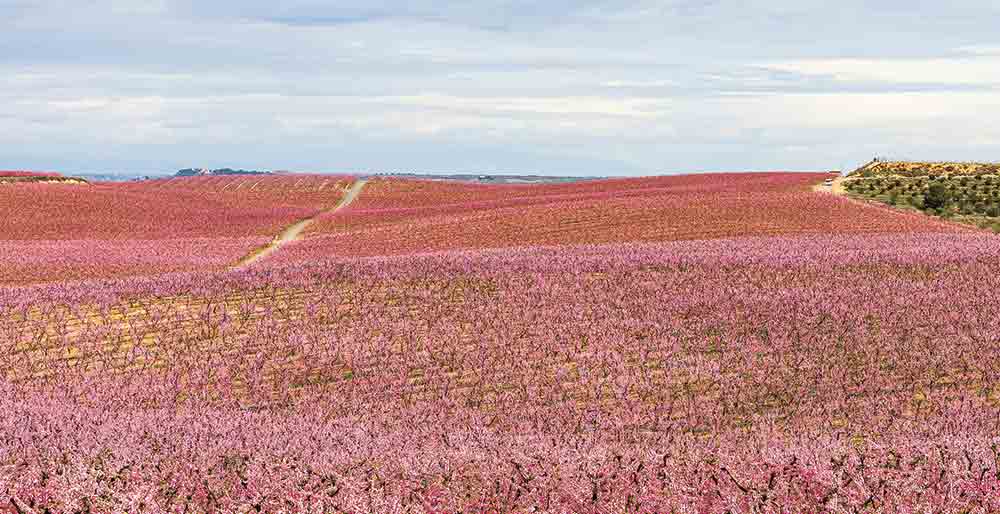
By Adam Russell
Texas A&M AgriLife Extension Communication Specialist
Winter and early spring weather related to chill hours has led to mixed results for Texas peach producers, according to Texas A&M AgriLife Extension Service experts. Parts of the state are reporting good fruit sets despite drought, while other areas are reporting late freeze damage and inadequate chill hours that have cut into potential peach yields. Jim Kamas, AgriLife Extension fruit specialist, Fredericksburg, said weather conditions like drought and insufficient chill hours worked against fruit tree production in the Hill Country this winter. Kamas said AgriLife Extension has been tracking chill hours – hours at or below 45 degrees after the last frost – in the Hill Country for more than 20 years, and by traditional measurements trees should receive around 830 hours of chilling. But the response from trees indicates they received around 530 chill hours.
Tree response to this season’s chill hours in the Hill Country has been abysmal. Trees were slow to leaf out and, while blooms looked normal, Kamas said trees shed them, which is a sign of incomplete bud differentiation. Some fruit is forming, but Kamas said he was uncertain whether they would progress or fall off. “Things don’t look good,” he said. “I don’t want to say there will be no peaches, but we’re looking at 30% of a typical season at best.”
Fruit trees, like peaches, apples and even blackberries, depend on cool weather in the winter to promote proper physiological growth in the spring. If plants do not receive the required number of chill hours, they can be slow to leaf out, which typically leads to poorly developed fruit or no fruit at all. Chill hours begin to add up after the first freeze each fall, Kamas said. Trees go dormant for winter, but chill hours promote hormones that dilute growth inhibitors throughout the winter and prepare the plant to break dormancy and begin new growth, bloom and set fruit. Proper chill hours trigger good and well-timed leaf and flower bud development. A lack of chill hours can lead to poorly developed buds and flowers that can have a cascading effect leading to stunted or misshaped fruit to no fruit at all. Leaves help trees produce energy and protect limbs from sun scald, but multiple seasons of inadequate chill hours can kill plants.
Kamas said the puzzling reaction to temperatures by fruit trees this winter is backed by some research that has shown different temperature ranges have variable impacts on the trees. Temperatures 38 degrees to 48 degrees are more efficient than temperatures above or below that range. The research also shows temperatures at or below freezing do not impact a tree’s chill requirements. “It makes sense because we had below-freezing temperatures for a week during that early winter ice storm,” he said. “That is about 300 hours that we traditionally count but likely had no effect. Most winters these freeze events balance out over a winter, but that didn’t happen.”
Related Articles
George Philley, Ph.D., owner of Philley Peach orchard in Overton and retired AgriLife Extension plant pathologist, said the lack of fruit set and leaf formation on several varieties suggests his trees received similarly inadequate chill hours. His low-chill varieties suffered another setback during the late freeze in March. Philley said those trees had dime- to quarter-sized peaches, but that two nights with below-freezing temperatures appear to have caused complete fruit losses.
“Last year, and this year, they recorded around 1,000 chill hours at the Texas A&M AgriLife center in Overton,” he said. “I had about one-third of a crop last year, and it looks like it might be the same this year. Varieties that I thought were not going to make a crop did last year, but 30% of what you are hoping for is not good.”
Bill Holcombe, AgriLife Extension agent in Clay County, said peach growers reported plenty of chill hours but also some light late freeze damage, leading to 45% to 80% fruit set survival rates. Higher losses occurred in orchards that received less maintenance from growers. Some producers burned piles of hay and brush within their orchards to keep the frost from damaging fruit, he said.
“Most of the damage was in lower lying pockets, but they were very positive about their fruit sets and their crops’ progress so far,” Holcomb said. Larry Stein, Ph.D., AgriLife Extension horticulturist, Uvalde, said low- to mid-chill varieties grown in the Winter Garden region set fruit well. Some fruit appears slightly elongated, which is a sign of not quite enough chilling. Growers were thinning trees to reduce the crop load to avoid overcropping, improve fruit size and allow trees to bounce back for next season. Drought conditions did not affect fruit set, but Stein said orchards need subsoil moisture levels to be replenished to reach ideal fruit size and for trees’ long-term health.
“My biggest concern is the dry weather,” he said. “Most producers irrigate, but irrigation is supplemental at best and can never replace rainfall. Producers are busy thinning before the pits harden to get the size increase and doing weed control because weeds steal moisture, but I would think it is going to be a typical season for the growers around here.”
You are a guest
or post as a guest
Be the first to comment.

